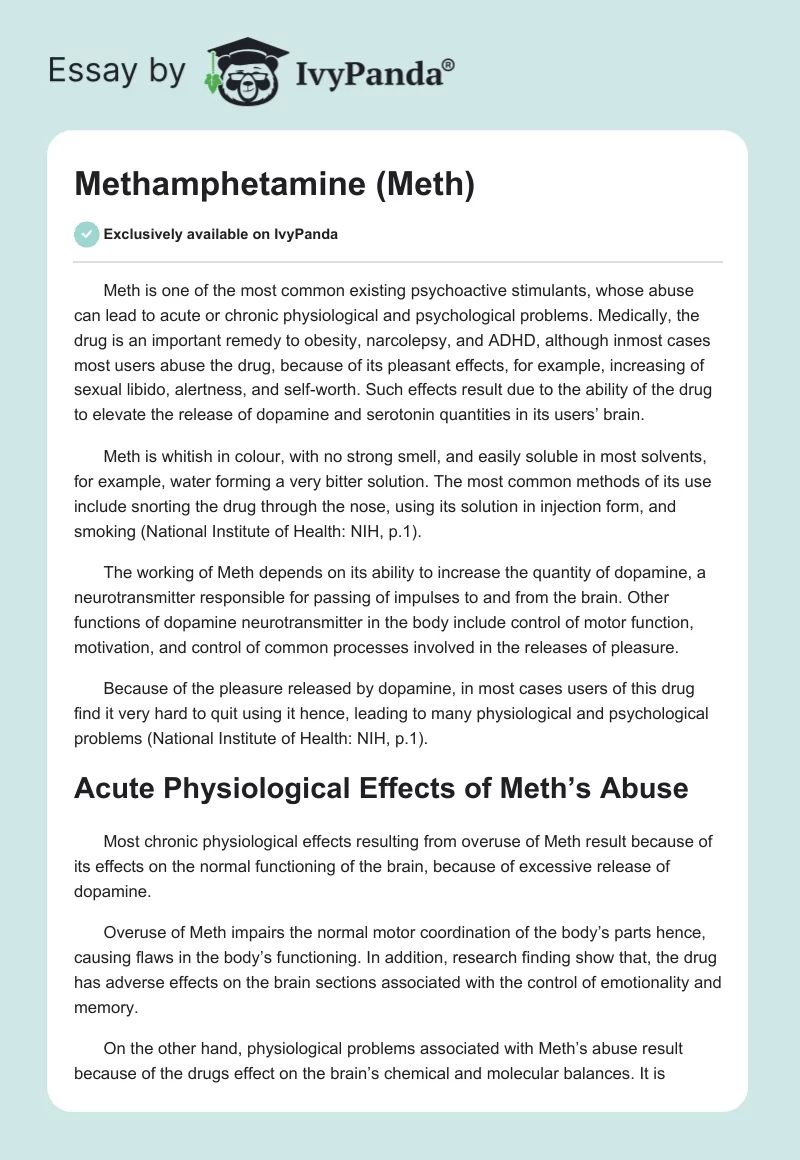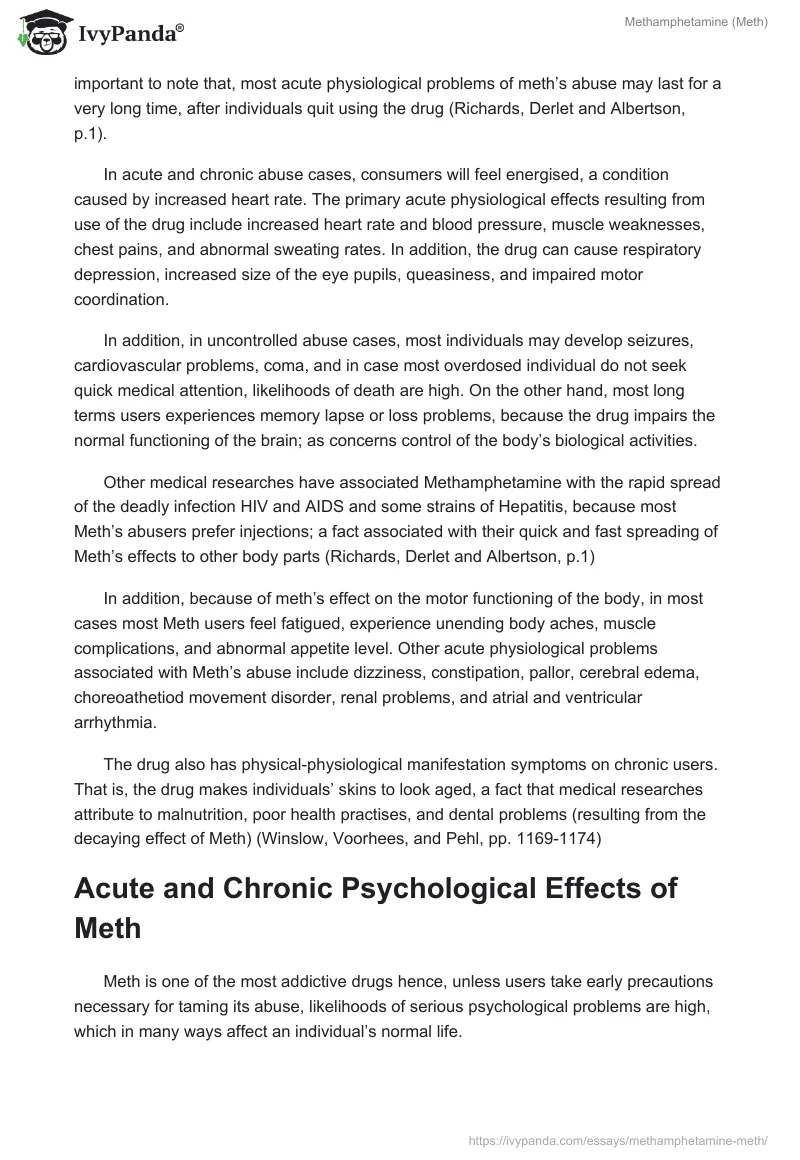Meth is one of the most common existing psychoactive stimulants, whose abuse can lead to acute or chronic physiological and psychological problems. Medically, the drug is an important remedy to obesity, narcolepsy, and ADHD, although inmost cases most users abuse the drug, because of its pleasant effects, for example, increasing of sexual libido, alertness, and self-worth. Such effects result due to the ability of the drug to elevate the release of dopamine and serotonin quantities in its users’ brain.
Meth is whitish in colour, with no strong smell, and easily soluble in most solvents, for example, water forming a very bitter solution. The most common methods of its use include snorting the drug through the nose, using its solution in injection form, and smoking (National Institute of Health: NIH, p.1).
The working of Meth depends on its ability to increase the quantity of dopamine, a neurotransmitter responsible for passing of impulses to and from the brain. Other functions of dopamine neurotransmitter in the body include control of motor function, motivation, and control of common processes involved in the releases of pleasure.
Because of the pleasure released by dopamine, in most cases users of this drug find it very hard to quit using it hence, leading to many physiological and psychological problems (National Institute of Health: NIH, p.1).
Acute Physiological Effects of Meth’s Abuse
Most chronic physiological effects resulting from overuse of Meth result because of its effects on the normal functioning of the brain, because of excessive release of dopamine.
Overuse of Meth impairs the normal motor coordination of the body’s parts hence, causing flaws in the body’s functioning. In addition, research finding show that, the drug has adverse effects on the brain sections associated with the control of emotionality and memory.
On the other hand, physiological problems associated with Meth’s abuse result because of the drugs effect on the brain’s chemical and molecular balances. It is important to note that, most acute physiological problems of meth’s abuse may last for a very long time, after individuals quit using the drug (Richards, Derlet and Albertson, p.1).
In acute and chronic abuse cases, consumers will feel energised, a condition caused by increased heart rate. The primary acute physiological effects resulting from use of the drug include increased heart rate and blood pressure, muscle weaknesses, chest pains, and abnormal sweating rates. In addition, the drug can cause respiratory depression, increased size of the eye pupils, queasiness, and impaired motor coordination.
In addition, in uncontrolled abuse cases, most individuals may develop seizures, cardiovascular problems, coma, and in case most overdosed individual do not seek quick medical attention, likelihoods of death are high. On the other hand, most long terms users experiences memory lapse or loss problems, because the drug impairs the normal functioning of the brain; as concerns control of the body’s biological activities.
Other medical researches have associated Methamphetamine with the rapid spread of the deadly infection HIV and AIDS and some strains of Hepatitis, because most Meth’s abusers prefer injections; a fact associated with their quick and fast spreading of Meth’s effects to other body parts (Richards, Derlet and Albertson, p.1)
In addition, because of meth’s effect on the motor functioning of the body, in most cases most Meth users feel fatigued, experience unending body aches, muscle complications, and abnormal appetite level. Other acute physiological problems associated with Meth’s abuse include dizziness, constipation, pallor, cerebral edema, choreoathetiod movement disorder, renal problems, and atrial and ventricular arrhythmia.
The drug also has physical-physiological manifestation symptoms on chronic users. That is, the drug makes individuals’ skins to look aged, a fact that medical researches attribute to malnutrition, poor health practises, and dental problems (resulting from the decaying effect of Meth) (Winslow, Voorhees, and Pehl, pp. 1169-1174)
Acute and Chronic Psychological Effects of Meth
Meth is one of the most addictive drugs hence, unless users take early precautions necessary for taming its abuse, likelihoods of serious psychological problems are high, which in many ways affect an individual’s normal life.
In most prolonged use cases, most individuals will experience some mental strain, caused by insomnia and increased alertness. Such extreme alertness levels can make most users to loose control of their lives hence, largely affecting their social life.
This is because, most long-term users are very irritable, aggressive, and always like to panic; hence, in most cases such users prefer to live in isolation. In addition, research findings on the psychological effects of the drug on long-term users also show that, there is a close correlation between psychosis and Meth, a fact attributed to the ability of the drug to cause paranoia.
On the other hand, to chronic users, the drug can cause auditory and visual hallucinations, which can lead to heightened emotionality and obsessive behaviours in individuals. Because of the addictive nature of the drug, any attempt to stop its usage can cause serious withdrawal problems, which can totally alter individuals’ behaviours, as most of them cannot manage withdrawal symptoms (Winslow, Voorhees, and Pehl, pp. 1169-1174).
Conclusion
In conclusion, meth is one of the most addictive drugs, with serious physiological and psychological complications hence, the need for individuals to watch their consumption habits. Because of the nature of emotional and physical trauma associated with the drug, it is advisable for users to seek early medical and psychological intervention or treatment. Common treatment remedies include cognitive-behavioural and contingence treatment interventions, there being no special medications to treat the addiction.
Works Cited
National Institute of Health. Methamphetamine. NIDA. 2010. Web.
Richards, John, Derlet, Robert, and Albertson, Timothy. Toxicity, methamphetamine.Medscape: E-medicine, 2009. Web.
Winslow, Bradford, Voorhees, Kenton, and Pehl, Katherine. Methamphetamine abuse. Am Farm Physician, 15; 76(8) (2007): 1196-1174. Web.


